alarm BMW X5 4.4I 2000 Owners Manual
[x] Cancel search | Manufacturer: BMW, Model Year: 2000, Model line: X5 4.4I, Model: BMW X5 4.4I 2000Pages: 201, PDF Size: 1.93 MB
Page 6 of 201

6n
For your own safety
Use unleaded gasoline only. Fuels
containing up to and including
10 % Ethanol or other oxygenates with
up to 2.8 % oxygen by weight (that is,
15 % MTBE or 3 % methanol plus an
equivalent amount of co-solvent) will
not void the applicable warranties re-
specting defects in materials or work-
manship. Field experience has indi-
cated significant differences in fuel
quality (volatility, composition, addi-
tives, etc.) among gasolines offered for
sale in the United States and Canada.
The use of poor quality fuels may result
in driveability, starting and stalling
problems especially under certain envi-
ronmental conditions such as high am-
bient temperature and high altitude.
Should you encounter driveability prob-
lems which you suspect could be re-
lated to the fuel you are using, we rec-
ommend that you respond by switching
to a recognized high-quality brand.
Failure to comply with these recom-
mendations may result in unscheduled
maintenance.
Follow the relevant safety rules when
you are handling gasoline.
<
Important safety information.
For your own safety, use genuine parts
and accessories approved by BMW.
When you purchase accessories tested
and approved by BMW and Original
BMW Parts, you simultaneously acquire
the assurance that they have been thor-
oughly tested by BMW to ensure opti-
mum performance when installed on
your vehicle.
BMW warrants these parts to be free
from defects in material and workman-
ship.
BMW will not accept any liability for
damage resulting from installation of
parts and accessories not approved by
BMW.
BMW cannot test every product from
other manufacturers to verify if it can be
used on a BMW safely and without risk
to either the vehicle, its operation, or its
occupants.
Original BMW Parts, BMW Accessories
and other products approved by BMW,
together with professional advice on
using these items, are available from all
BMW centers.
Installation and operation of non-BMW
approved accessories such as alarms,
radios, amplifiers, radar detectors,
wheels, suspension components, brake
dust shields, telephones (including op-
eration of any portable cellular phone
from within the vehicle without using an
externally mounted antenna) or trans-
ceiver equipment (for instance, CBs,
walkie-talkie, ham radio or similar ac-
cessories) may cause extensive dam-
age to the vehicle, compromise its
safety, interfere with the vehicle's elec-
trical system or affect the validity of the
BMW Limited Warranty. See your au-
thorized BMW center for additional in-
formation.
<
Maintenance, replacement, or
repair of the emission control de-
vices and systems may be performed
by any automotive repair establishment
or individual using any certified auto-
motive part.
<
Symbol on vehicle parts
Indicates that you should consult
the relevant section of this
Owner's Manual for information on a
particular part or assembly.
For your own safety
Page 10 of 201
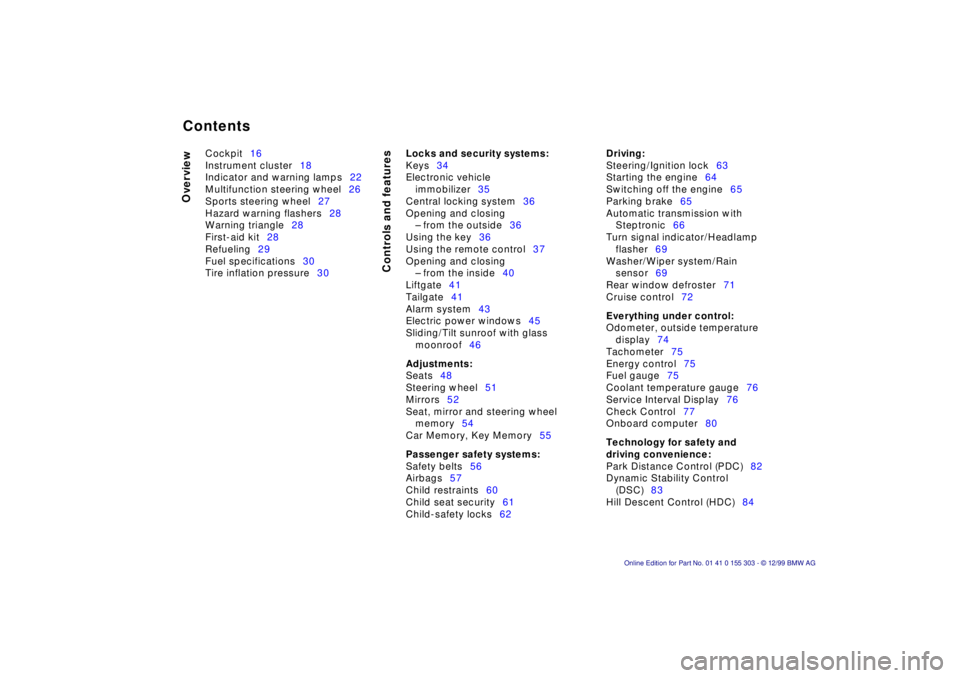
Contents
Overview
Controls and features
Cockpit16
Instrument cluster18
Indicator and warning lamps22
Multifunction steering wheel26
Sports steering wheel27
Hazard warning flashers28
Warning triangle28
First-aid kit28
Refueling29
Fuel specifications30
Tire inflation pressure30
Locks and security systems:
Keys34
Electronic vehicle
immobilizer35
Central locking system36
Opening and closing
Ð from the outside36
Using the key36
Using the remote control37
Opening and closing
Ð from the inside40
Liftgate41
Tailgate41
Alarm system43
Electric power windows45
Sliding/Tilt sunroof with glass
moonroof46
Adjustments:
Seats48
Steering wheel51
Mirrors52
Seat, mirror and steering wheel
memory54
Car Memory, Key Memory55
Passenger safety systems:
Safety belts56
Airbags57
Child restraints60
Child seat security61
Child-safety locks62
Driving:
Steering/Ignition lock63
Starting the engine64
Switching off the engine65
Parking brake65
Automatic transmission with
Steptronic66
Turn signal indicator/Headlamp
flasher69
Washer/Wiper system/Rain
sensor69
Rear window defroster71
Cruise control72
Everything under control:
Odometer, outside temperature
display74
Tachometer75
Energy control75
Fuel gauge75
Coolant temperature gauge76
Service Interval Display76
Check Control77
Onboard computer80
Technology for safety and
driving convenience:
Park Distance Control (PDC)82
Dynamic Stability Control
(DSC)83
Hill Descent Control (HDC)84
Contents
Page 32 of 201
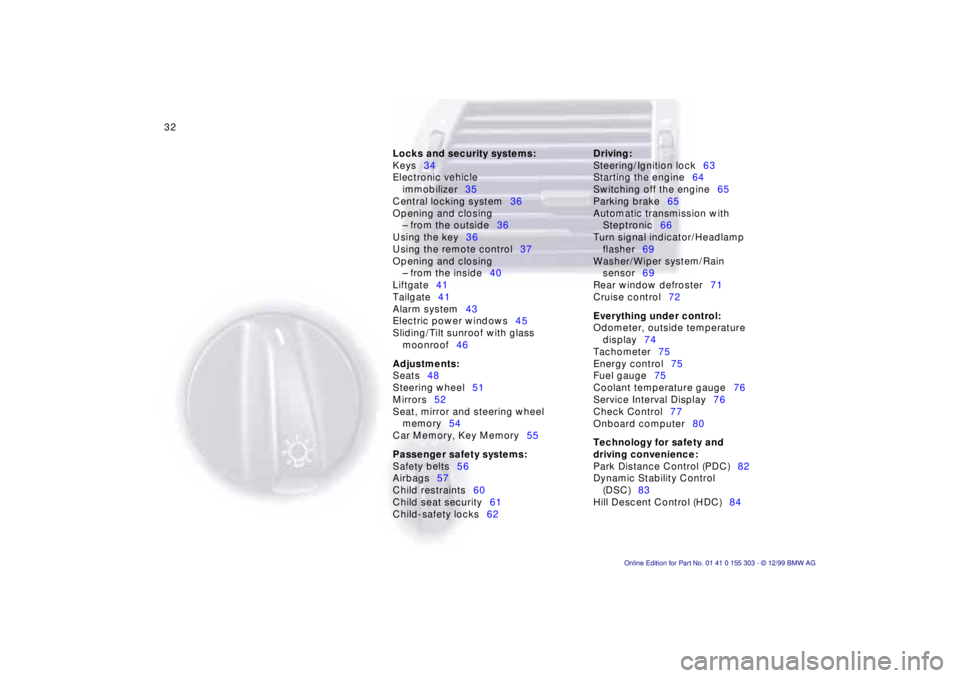
32n
Locks and security systems:
Keys34
Electronic vehicle
immobilizer35
Central locking system36
Opening and closing
Ð from the outside36
Using the key36
Using the remote control37
Opening and closing
Ð from the inside40
Liftgate41
Tailgate41
Alarm system43
Electric power windows45
Sliding/Tilt sunroof with glass
moonroof46
Adjustments:
Seats48
Steering wheel51
Mirrors52
Seat, mirror and steering wheel
memory54
Car Memory, Key Memory55
Passenger safety systems:
Safety belts56
Airbags57
Child restraints60
Child seat security61
Child-safety locks62Driving:
Steering/Ignition lock63
Starting the engine64
Switching off the engine65
Parking brake65
Automatic transmission with
Steptronic66
Turn signal indicator/Headlamp
flasher69
Washer/Wiper system/Rain
sensor69
Rear window defroster71
Cruise control72
Everything under control:
Odometer, outside temperature
display74
Tachometer75
Energy control75
Fuel gauge75
Coolant temperature gauge76
Service Interval Display76
Check Control77
Onboard computer80
Technology for safety and
driving convenience:
Park Distance Control (PDC)82
Dynamic Stability Control
(DSC)83
Hill Descent Control (HDC)84
Controls
Page 36 of 201
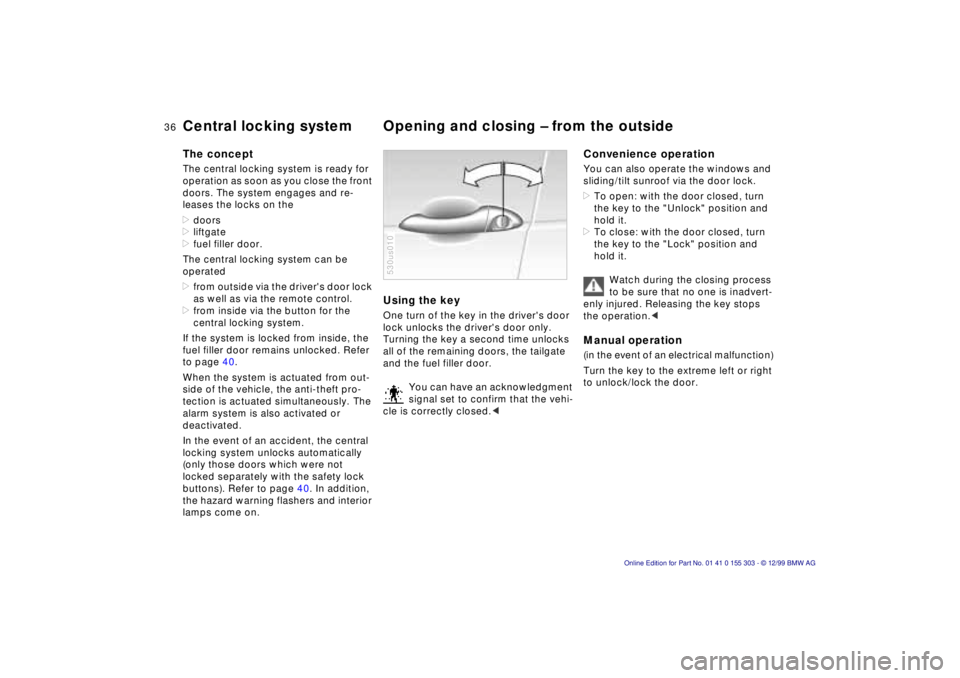
36n
Central locking system Opening and closing Ð from the outside The concept The central locking system is ready for
operation as soon as you close the front
doors. The system engages and re-
leases the locks on the
>doors
>liftgate
>fuel filler door.
The central locking system can be
operated
>from outside via the driver's door lock
as well as via the remote control.
>from inside via the button for the
central locking system.
If the system is locked from inside, the
fuel filler door remains unlocked. Refer
to page 40.
When the system is actuated from out-
side of the vehicle, the anti-theft pro-
tection is actuated simultaneously. The
alarm system is also activated or
deactivated.
In the event of an accident, the central
locking system unlocks automatically
(only those doors which were not
locked separately with the safety lock
buttons). Refer to page 40. In addition,
the hazard warning flashers and interior
lamps come on.
Using the key One turn of the key in the driver's door
lock unlocks the driver's door only.
Turning the key a second time unlocks
all of the remaining doors, the tailgate
and the fuel filler door.
You can have an acknowledgment
signal set to confirm that the vehi-
cle is correctly closed.< 530us010
Convenience operation You can also operate the windows and
sliding/tilt sunroof via the door lock.
>To open: with the door closed, turn
the key to the "Unlock" position and
hold it.
>To close: with the door closed, turn
the key to the "Lock" position and
hold it.
Watch during the closing process
to be sure that no one is inadvert-
enly injured. Releasing the key stops
the operation.< Manual operation (in the event of an electrical malfunction)
Turn the key to the extreme left or right
to unlock/lock the door.
Page 37 of 201
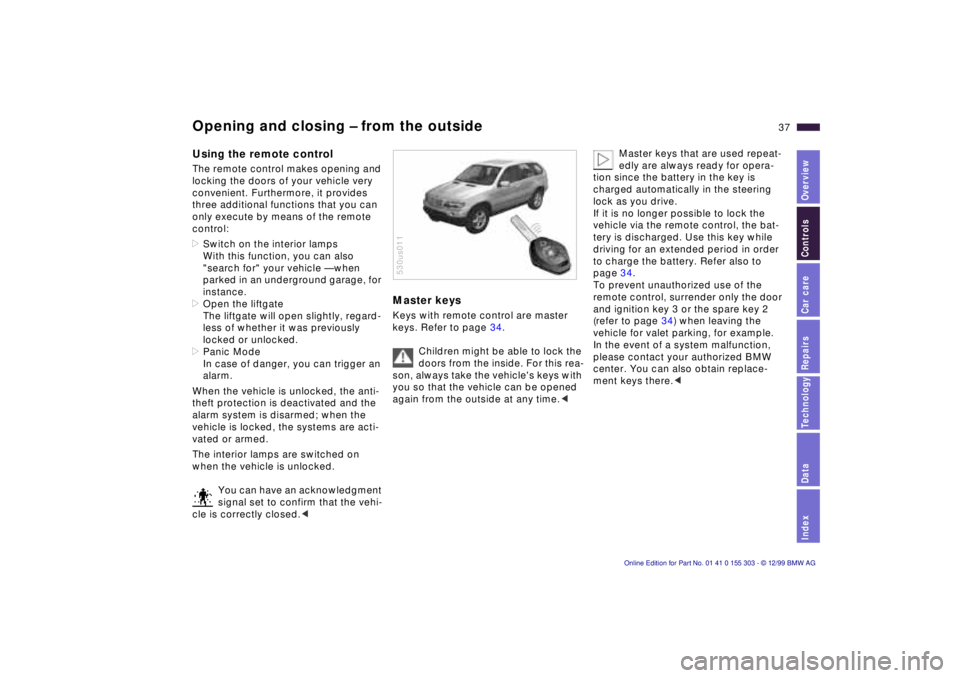
IndexDataTechnologyRepairsCar careControlsOverview
37n
Opening and closing Ð from the outside Using the remote control The remote control makes opening and
locking the doors of your vehicle very
convenient. Furthermore, it provides
three additional functions that you can
only execute by means of the remote
control:
>Switch on the interior lamps
With this function, you can also
"search for" your vehicle Ñ when
parked in an underground garage, for
instance.
>Open the liftgate
The liftgate will open slightly, regard-
less of whether it was previously
locked or unlocked.
>Panic Mode
In case of danger, you can trigger an
alarm.
When the vehicle is unlocked, the anti-
theft protection is deactivated and the
alarm system is disarmed; when the
vehicle is locked, the systems are acti-
vated or armed.
The interior lamps are switched on
when the vehicle is unlocked.
You can have an acknowledgment
signal set to confirm that the vehi-
cle is correctly closed.<
Master keys Keys with remote control are master
keys. Refer to page 34.
Children might be able to lock the
doors from the inside. For this rea-
son, always take the vehicle's keys with
you so that the vehicle can be opened
again from the outside at any time.< 530us011
Master keys that are used repeat-
edly are always ready for opera-
tion since the battery in the key is
charged automatically in the steering
lock as you drive.
If it is no longer possible to lock the
vehicle via the remote control, the bat-
tery is discharged. Use this key while
driving for an extended period in order
to charge the battery. Refer also to
page 34.
To prevent unauthorized use of the
remote control, surrender only the door
and ignition key 3 or the spare key 2
(refer to page 34) when leaving the
vehicle for valet parking, for example.
In the event of a system malfunction,
please contact your authorized BMW
center. You can also obtain replace-
ment keys there.<
Page 38 of 201
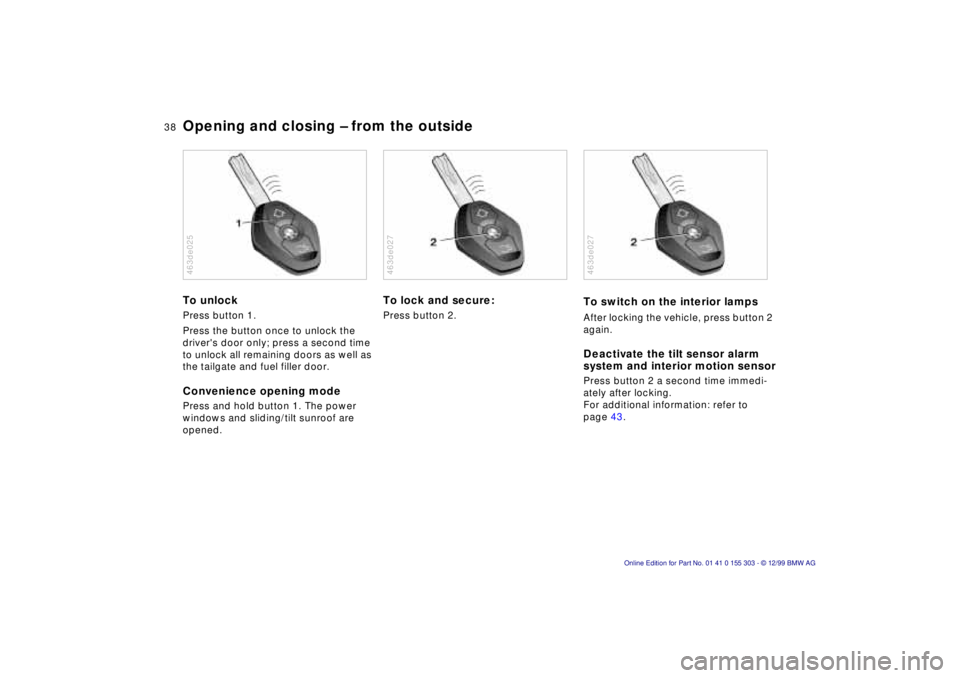
38n
Opening and closing Ð from the outside To unlock Press button 1.
Press the button once to unlock the
driver's door only; press a second time
to unlock all remaining doors as well as
the tailgate and fuel filler door. Convenience opening mode Press and hold button 1. The power
windows and sliding/tilt sunroof are
opened. 463de025
To lock and secure: Press button 2. 463de027
To switch on the interior lamps After locking the vehicle, press button 2
again. Deactivate the tilt sensor alarm
system and interior motion sensorPress button 2 a second time immedi-
ately after locking.
For additional information: refer to
page 43. 463de027
Page 39 of 201
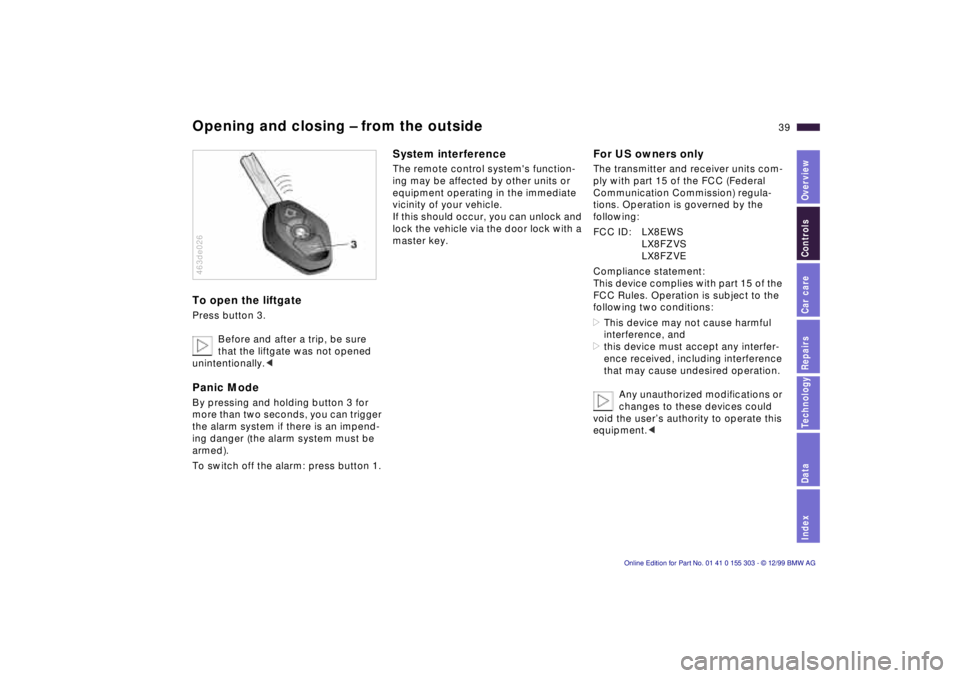
IndexDataTechnologyRepairsCar careControlsOverview
39n
Opening and closing Ð from the outside To open the liftgate Press button 3.
Before and after a trip, be sure
that the liftgate was not opened
unintentionally.< Panic Mode By pressing and holding button 3 for
more than two seconds, you can trigger
the alarm system if there is an impend-
ing danger (the alarm system must be
armed).
To switch off the alarm: press button 1. 463de026
System interference The remote control system's function-
ing may be affected by other units or
equipment operating in the immediate
vicinity of your vehicle.
If this should occur, you can unlock and
lock the vehicle via the door lock with a
master key.
For US owners only The transmitter and receiver units com-
ply with part 15 of the FCC (Federal
Communication Commission) regula-
tions. Operation is governed by the
following:
FCC ID: LX8EWS
LX8FZVS
LX8FZVE
Compliance statement:
This device complies with part 15 of the
FCC Rules. Operation is subject to the
following two conditions:
>This device may not cause harmful
interference, and
>this device must accept any interfer-
ence received, including interference
that may cause undesired operation.
Any unauthorized modifications or
changes to these devices could
void the userÕs authority to operate this
equipment.<
Page 40 of 201
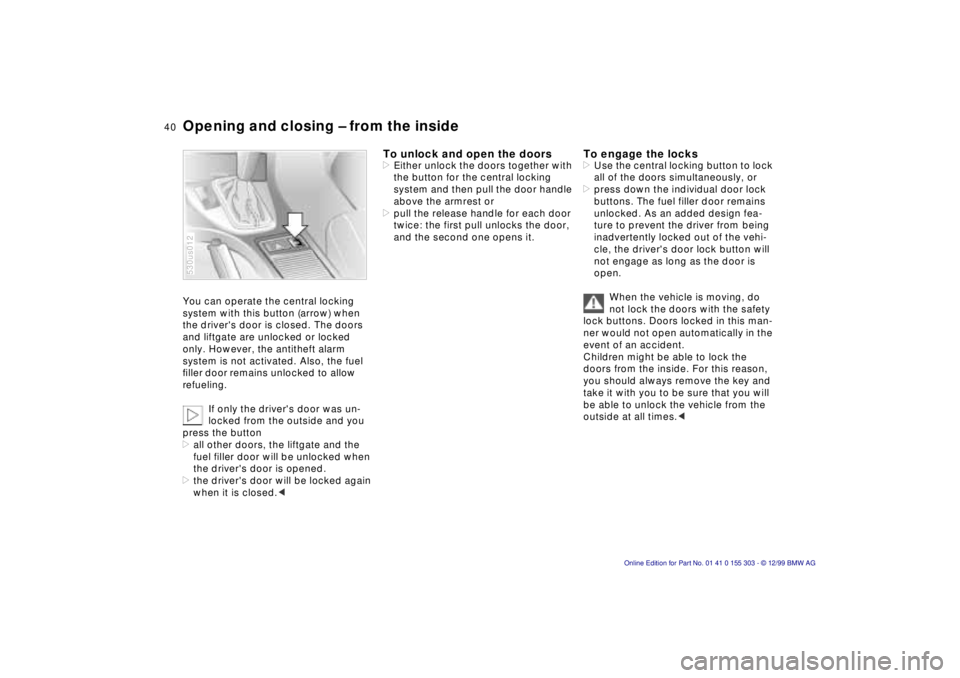
40n
Opening and closing Ð from the inside You can operate the central locking
system with this button (arrow) when
the driver's door is closed. The doors
and liftgate are unlocked or locked
only. However, the antitheft alarm
system is not activated. Also, the fuel
Þller door remains unlocked to allow
refueling.
If only the driver's door was un-
locked from the outside and you
press the button
>all other doors, the liftgate and the
fuel filler door will be unlocked when
the driver's door is opened.
>the driver's door will be locked again
when it is closed.< 530us012
To unlock and open the doors >Either unlock the doors together with
the button for the central locking
system and then pull the door handle
above the armrest or
>pull the release handle for each door
twice: the first pull unlocks the door,
and the second one opens it.
To engage the locks >Use the central locking button to lock
all of the doors simultaneously, or
>press down the individual door lock
buttons. The fuel filler door remains
unlocked. As an added design fea-
ture to prevent the driver from being
inadvertently locked out of the vehi-
cle, the driver's door lock button will
not engage as long as the door is
open.
When the vehicle is moving, do
not lock the doors with the safety
lock buttons. Doors locked in this man-
ner would not open automatically in the
event of an accident.
Children might be able to lock the
doors from the inside. For this reason,
you should always remove the key and
take it with you to be sure that you will
be able to unlock the vehicle from the
outside at all times.<
Page 43 of 201
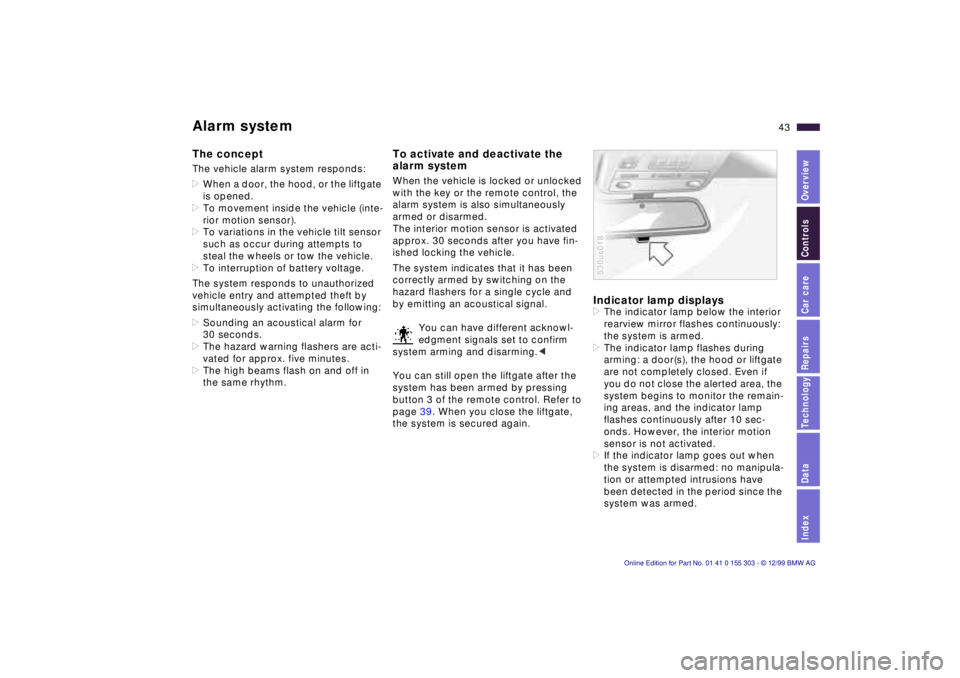
IndexDataTechnologyRepairsCar careControlsOverview
43n
Alarm system The concept The vehicle alarm system responds:
>When a door, the hood, or the liftgate
is opened.
>To movement inside the vehicle (inte-
rior motion sensor).
>To variations in the vehicle tilt sensor
such as occur during attempts to
steal the wheels or tow the vehicle.
>To interruption of battery voltage.
The system responds to unauthorized
vehicle entry and attempted theft by
simultaneously activating the following:
>Sounding an acoustical alarm for
30 seconds.
>The hazard warning flashers are acti-
vated for approx. five minutes.
>The high beams flash on and off in
the same rhythm.
To activate and deactivate the
alarm system When the vehicle is locked or unlocked
with the key or the remote control, the
alarm system is also simultaneously
armed or disarmed.
The interior motion sensor is activated
approx. 30 seconds after you have fin-
ished locking the vehicle.
The system indicates that it has been
correctly armed by switching on the
hazard flashers for a single cycle and
by emitting an acoustical signal.
You can have different acknowl-
edgment signals set to confirm
system arming and disarming.<
You can still open the liftgate after the
system has been armed by pressing
button 3 of the remote control. Refer to
page 39. When you close the liftgate,
the system is secured again.
Indicator lamp displays >The indicator lamp below the interior
rearview mirror flashes continuously:
the system is armed.
>The indicator lamp flashes during
arming: a door(s), the hood or liftgate
are not completely closed. Even if
you do not close the alerted area, the
system begins to monitor the remain-
ing areas, and the indicator lamp
flashes continuously after 10 sec-
onds. However, the interior motion
sensor is not activated.
>If the indicator lamp goes out when
the system is disarmed: no manipula-
tion or attempted intrusions have
been detected in the period since the
system was armed. 530us018
Page 44 of 201
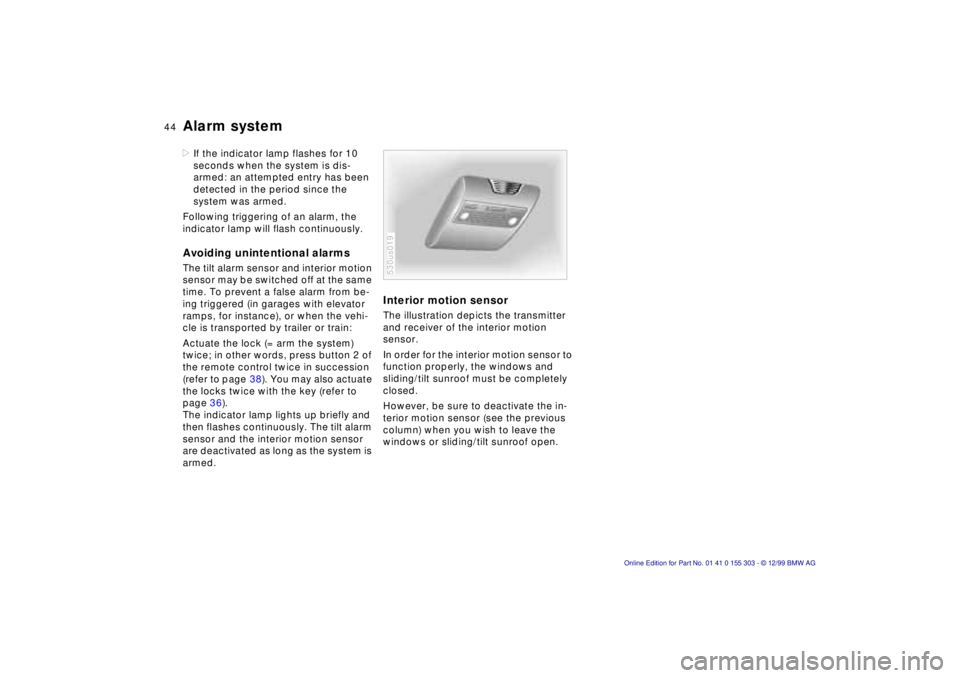
44n
Alarm system >If the indicator lamp flashes for 10
seconds when the system is dis-
armed: an attempted entry has been
detected in the period since the
system was armed.
Following triggering of an alarm, the
indicator lamp will flash continuously. Avoiding unintentional alarms The tilt alarm sensor and interior motion
sensor may be switched off at the same
time. To prevent a false alarm from be-
ing triggered (in garages with elevator
ramps, for instance), or when the vehi-
cle is transported by trailer or train:
Actuate the lock (= arm the system)
twice; in other words, press button 2 of
the remote control twice in succession
(refer to page 38). You may also actuate
the locks twice with the key (refer to
page 36).
The indicator lamp lights up briefly and
then flashes continuously. The tilt alarm
sensor and the interior motion sensor
are deactivated as long as the system is
armed.
Interior motion sensor The illustration depicts the transmitter
and receiver of the interior motion
sensor.
In order for the interior motion sensor to
function properly, the windows and
sliding/tilt sunroof must be completely
closed.
However, be sure to deactivate the in-
terior motion sensor (see the previous
column) when you wish to leave the
windows or sliding/tilt sunroof open. 530us019